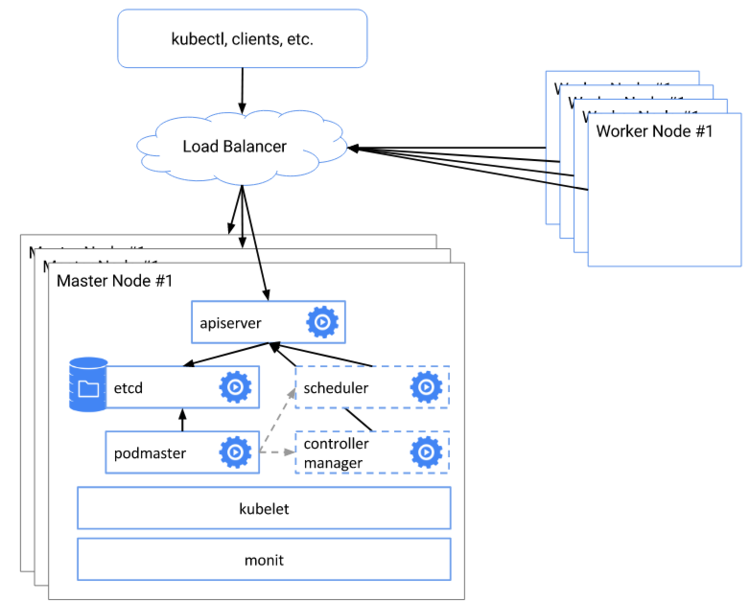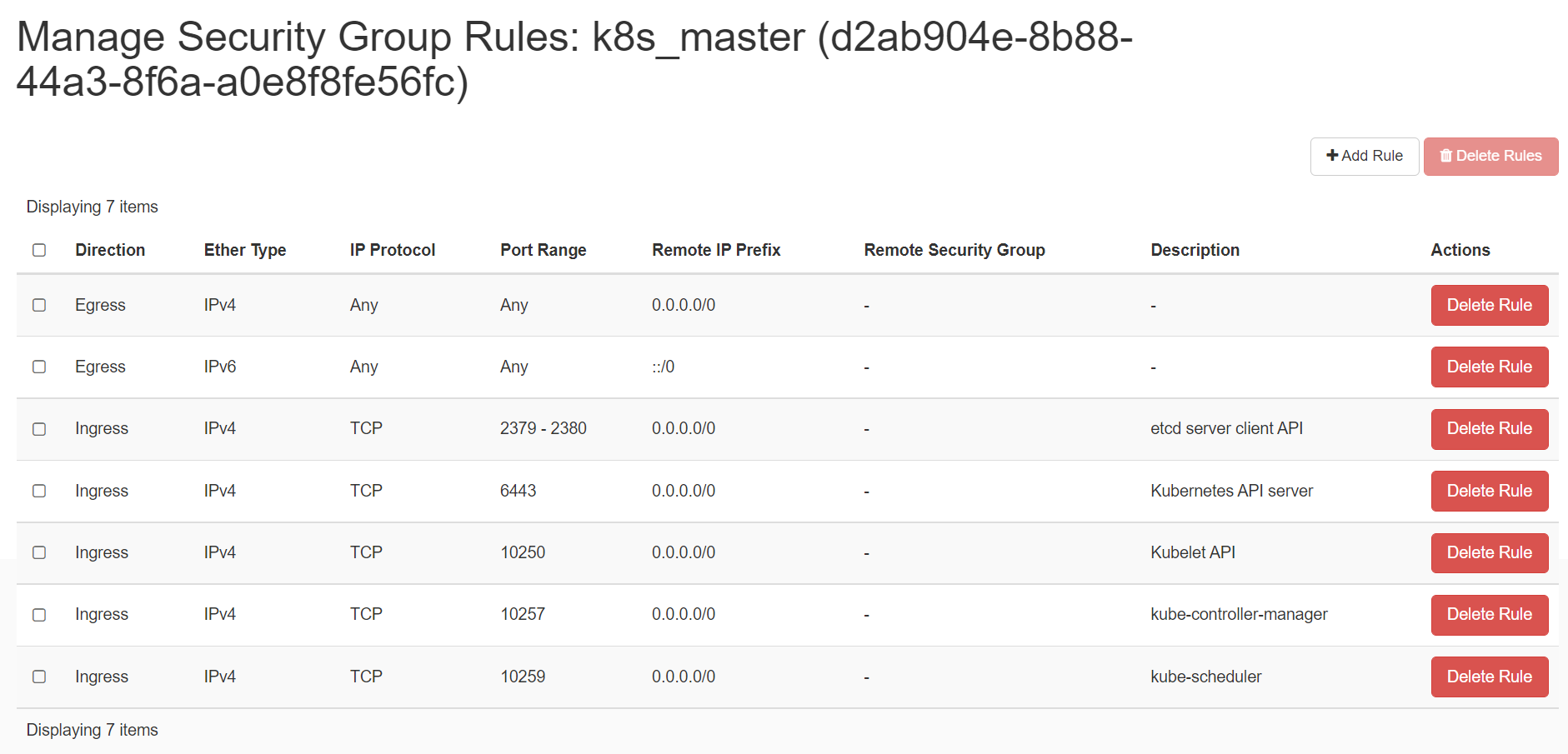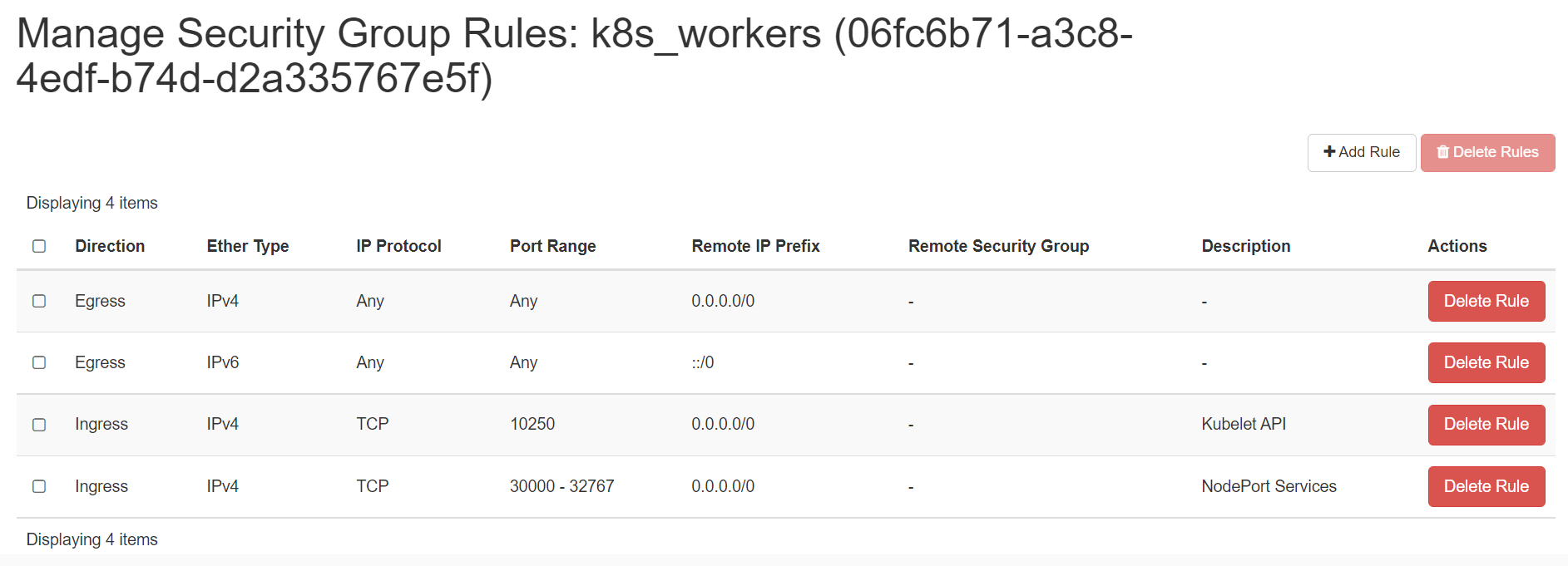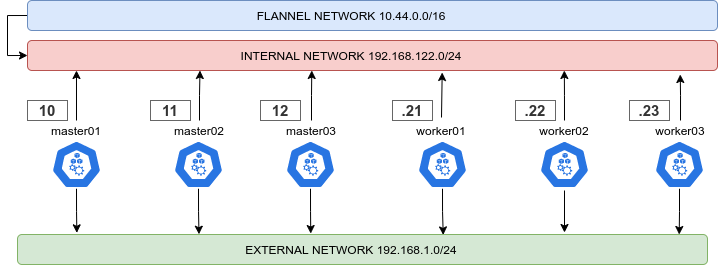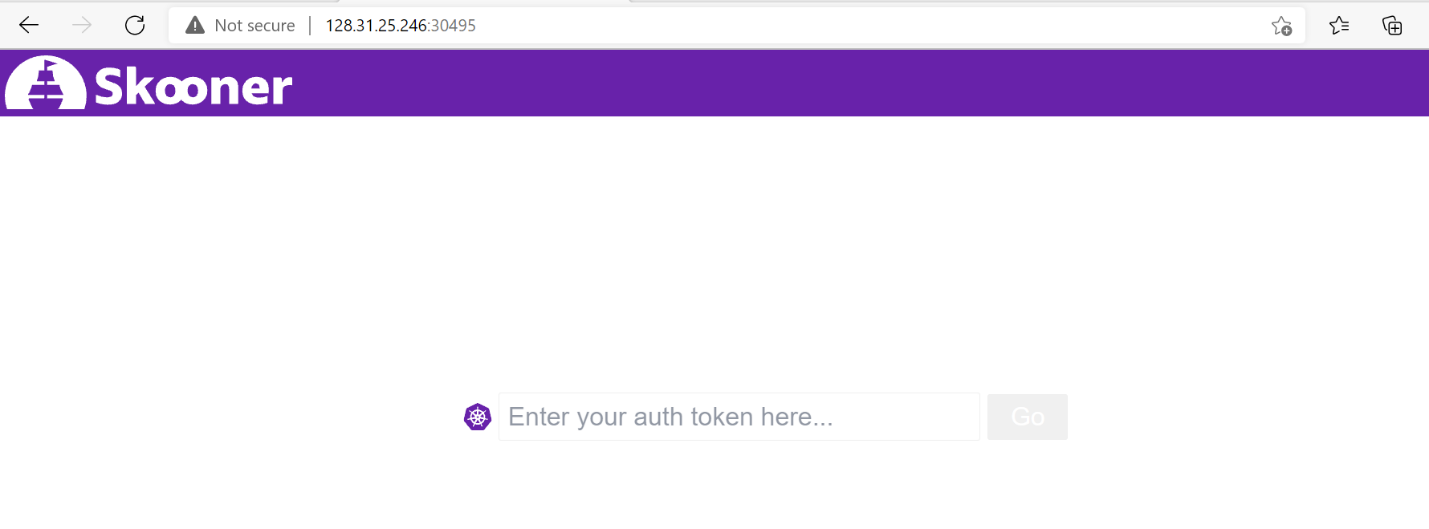Highly Available Kubernetes Cluster using kubeadm
Objectives
-
Install a multi control-plane(master) Kubernetes cluster
-
Install a Pod network on the cluster so that your Pods can talk to each other
-
Deploy and test a sample app
-
Deploy K8s Dashboard to view all cluster's components
Components and architecure
This shows components and architecture of a highly-available, production-grade Kubernetes cluster.
You can learn about each component from Kubernetes Componets.
Pre-requisite
You will need 2 control-plane(master node) and 2 worker nodes to create a
multi-master kubernetes cluster using kubeadm. You are going to use the
following set up for this purpose:
-
2 Linux machines for master,
ubuntu-20.04-x86_64or your choice of Ubuntu OS image,cpu-su.2flavor with 2vCPU, 8GB RAM, 20GB storage. -
2 Linux machines for worker,
ubuntu-20.04-x86_64or your choice of Ubuntu OS image,cpu-su.1flavor with 1vCPU, 4GB RAM, 20GB storage - also assign Floating IPs to both of the worker nodes. -
1 Linux machine for loadbalancer,
ubuntu-20.04-x86_64or your choice of Ubuntu OS image,cpu-su.1flavor with 1vCPU, 4GB RAM, 20GB storage. -
ssh access to all machines: Read more here on how to setup SSH to your remote VMs.
-
Create 2 security groups with appropriate ports and protocols:
i. To be used by the master nodes:
ii. To be used by the worker nodes:
-
setup Unique hostname to each machine using the following command:
echo "<node_internal_IP> <host_name>" >> /etc/hosts hostnamectl set-hostname <host_name>For example:
echo "192.168.0.167 loadbalancer" >> /etc/hosts hostnamectl set-hostname loadbalancer
Steps
-
Prepare the Loadbalancer node to communicate with the two master nodes' apiservers on their IPs via port 6443.
-
Do following in all the nodes except the Loadbalancer node:
-
Disable swap.
-
Install
kubeletandkubeadm. -
Install container runtime - you will be using
containerd.
-
-
Initiate
kubeadmcontrol plane configuration on one of the master nodes. -
Save the new master and worker node join commands with the token.
-
Join the second master node to the control plane using the join command.
-
Join the worker nodes to the control plane using the join command.
-
Configure kubeconfig(
$HOME/.kube/config) on loadbalancer node. -
Install
kubectlon Loadbalancer node. -
Install CNI network plugin i.e. Flannel on Loadbalancer node.
-
Validate all cluster components and nodes are visible on Loadbalancer node.
-
Deploy a sample app and validate the app from Loadbalancer node.
Setting up loadbalancer
You will use HAPROXY as the primary loadbalancer, but you can use any other options as well. This node will be not part of the K8s cluster but will be outside of the cluster and interacts with the cluster using ports.
You have 2 master nodes. Which means the user can connect to either of the 2 apiservers. The loadbalancer will be used to loadbalance between the 2 apiservers.
-
Login to the loadbalancer node
-
Switch as root -
sudo su -
Update your repository and your system
sudo apt-get update && sudo apt-get upgrade -y -
Install haproxy
sudo apt-get install haproxy -y -
Edit haproxy configuration
vi /etc/haproxy/haproxy.cfgAdd the below lines to create a frontend configuration for loadbalancer -
frontend fe-apiserver bind 0.0.0.0:6443 mode tcp option tcplog default_backend be-apiserverAdd the below lines to create a backend configuration for master1 and master2 nodes at port 6443.
Note
6443 is the default port of kube-apiserver
backend be-apiserver mode tcp option tcplog option tcp-check balance roundrobin default-server inter 10s downinter 5s rise 2 fall 2 slowstart 60s maxconn 250 maxqueue 256 weight 100 server master1 10.138.0.15:6443 check server master2 10.138.0.16:6443 checkHere - master1 and master2 are the hostnames of the master nodes and 10.138.0.15 and 10.138.0.16 are the corresponding internal IP addresses.
-
Ensure haproxy config file is correctly formatted:
haproxy -c -q -V -f /etc/haproxy/haproxy.cfg -
Restart and Verify haproxy
systemctl restart haproxy systemctl status haproxyEnsure haproxy is in running status.
Run
nccommand as below:nc -v localhost 6443 Connection to localhost 6443 port [tcp/*] succeeded!Note
If you see failures for
master1andmaster2connectivity, you can ignore them for time being as you have not yet installed anything on the servers.
Install kubeadm, kubelet and containerd on master and worker nodes
kubeadm will not install or manage kubelet or kubectl for you, so you will
need to ensure they match the version of the Kubernetes control plane you want kubeadm
to install for you. You will install these packages on all of your machines:
• kubeadm: the command to bootstrap the cluster.
• kubelet: the component that runs on all of the machines in your cluster and does things like starting pods and containers.
• kubectl: the command line util to talk to your cluster.
In this step, you will install kubelet and kubeadm on the below nodes
-
master1
-
master2
-
worker1
-
worker2
The below steps will be performed on all the above mentioned nodes:
-
SSH into all the 4 machines
-
Update the repositories and packages:
sudo apt-get update && sudo apt-get upgrade -y -
Turn off
swapswapoff -a sudo sed -i '/ swap / s/^/#/' /etc/fstab -
Install
curlandapt-transport-httpssudo apt-get update && sudo apt-get install -y apt-transport-https curl -
Download the Google Cloud public signing key and add key to verify releases
curl -s https://packages.cloud.google.com/apt/doc/apt-key.gpg | sudo apt-key add - -
add kubernetes apt repo
cat <<EOF | sudo tee /etc/apt/sources.list.d/kubernetes.list deb https://apt.kubernetes.io/ kubernetes-xenial main EOF -
Install kubelet and kubeadm
sudo apt-get update sudo apt-get install -y kubelet kubeadm -
apt-mark holdis used so that these packages will not be updated/removed automaticallysudo apt-mark hold kubelet kubeadm
Install the container runtime i.e. containerd on master and worker nodes
To run containers in Pods, Kubernetes uses a container runtime.
By default, Kubernetes uses the Container Runtime Interface (CRI) to interface with your chosen container runtime.
-
Install container runtime - containerd
The first thing to do is configure the persistent loading of the necessary
containerdmodules. This forwarding IPv4 and letting iptables see bridged trafficis is done with the following command:cat <<EOF | sudo tee /etc/modules-load.d/k8s.conf overlay br_netfilter EOF sudo modprobe overlay sudo modprobe br_netfilter -
Ensure
net.bridge.bridge-nf-call-iptablesis set to1in your sysctl config:# sysctl params required by setup, params persist across reboots cat <<EOF | sudo tee /etc/sysctl.d/k8s.conf net.bridge.bridge-nf-call-iptables = 1 net.bridge.bridge-nf-call-ip6tables = 1 net.ipv4.ip_forward = 1 EOF -
Apply sysctl params without reboot:
sudo sysctl --system -
Install the necessary dependencies with:
sudo apt install -y curl gnupg2 software-properties-common apt-transport-https ca-certificates -
The
containerd.iopackages in DEB and RPM formats are distributed by Docker. Add the required GPG key with:curl -fsSL https://download.docker.com/linux/ubuntu/gpg | sudo apt-key add - sudo add-apt-repository "deb [arch=amd64] https://download.docker.com/linux/ubuntu $(lsb_release -cs) stable"It's now time to Install and configure containerd:
sudo apt update -y sudo apt install -y containerd.io containerd config default | sudo tee /etc/containerd/config.toml # Reload the systemd daemon with sudo systemctl daemon-reload # Start containerd sudo systemctl restart containerd sudo systemctl enable --now containerdYou can verify
containerdis running with the command:sudo systemctl status containerd
Configure kubeadm to bootstrap the cluster
You will start off by initializing only one master node. For this purpose, you
choose master1 to initialize our first control plane but you can also do the
same in master2.
-
SSH into master1 machine
-
Switch to root user:
sudo suConfiguring the kubelet cgroup driver
From 1.22 onwards, if you do not set the
cgroupDriverfield underKubeletConfiguration,kubeadmwill default it tosystemd. So you do not need to do anything here by default but if you want you change it you can refer to this documentation. -
Execute the below command to initialize the cluster:
kubeadm config images pull kubeadm init --control-plane-endpoint "LOAD_BALANCER_IP_OR_HOSTNAME:LOAD_BALANCER_PORT" --upload-certs --pod-network-cidr=10.244.0.0/16Here, you can use either the IP address or the hostname of the loadbalancer in place of
. You have not enabled the hostname of the server, i.e. loadbalanceras the LOAD_BALANCER_IP_OR_HOSTNAME that is visible from the master1 node. so instead of using not resolvable hostnames across your network, you will be using the IP address of the Loadbalancer server.The
is the front end configuration port defined in HAPROXY configuration. For this, you have kept the port as 6443 which is the default apiserverport.Important Note
--pod-network-cidrvalue depends upon what CNI plugin you going to use so need to be very careful while setting this CIDR values. In our case, you are going to use Flannel CNI network plugin so you will use:--pod-network-cidr=10.244.0.0/16. If you are opted to use Calico CNI network plugin then you need to use:--pod-network-cidr=192.168.0.0/16and if you are opted to use Weave Net no need to pass this parameter.For example, our
FlannelCNI network plugin based kubeadm init command with loadbalancer node with internal IP:192.168.0.167look like below:kubeadm config images pull kubeadm init --control-plane-endpoint "192.168.0.167:6443" --upload-certs --pod-network-cidr=10.244.0.0/16Save the output in some secure file for future use. This will show an unique token to join the control plane. The output from
kubeadm initshould looks like below:Your Kubernetes control-plane has initialized successfully! To start using your cluster, you need to run the following as a regular user: mkdir -p $HOME/.kube sudo cp -i /etc/kubernetes/admin.conf $HOME/.kube/config sudo chown $(id -u):$(id -g) $HOME/.kube/config Alternatively, if you are the root user, you can run: export KUBECONFIG=/etc/kubernetes/admin.conf You should now deploy a pod network to the cluster. Run "kubectl apply -f [podnetwork].yaml" with one of the options listed at: https://kubernetes.io/docs/concepts/cluster-administration/addons/ You can now join any number of the control-plane node running the following command on each worker nodes as root: kubeadm join 192.168.0.167:6443 --token cnslau.kd5fjt96jeuzymzb \ --discovery-token-ca-cert-hash sha256:871ab3f050bc9790c977daee9e44cf52e15ee3 7ab9834567333b939458a5bfb5 \ --control-plane --certificate-key 824d9a0e173a810416b4bca7038fb33b616108c17abcbc5eaef8651f11e3d146 Please note that the certificate-key gives access to cluster sensitive data, keep it secret! As a safeguard, uploaded-certs will be deleted in two hours; If necessary, you can use "kubeadm init phase upload-certs --upload-certs" to reload certs afterward. Then you can join any number of worker nodes by running the following on each as root: kubeadm join 192.168.0.167:6443 --token cnslau.kd5fjt96jeuzymzb \ --discovery-token-ca-cert-hash sha256:871ab3f050bc9790c977daee9e44cf52e15ee37ab9834567333b939458a5bfb5The output consists of 3 major tasks:
A. Setup
kubeconfigusing on current master node: As you are running asrootuser so you need to run the following command:export KUBECONFIG=/etc/kubernetes/admin.confWe need to run the below commands as a normal user to use the kubectl from terminal.
mkdir -p $HOME/.kube sudo cp -i /etc/kubernetes/admin.conf $HOME/.kube/config sudo chown $(id -u):$(id -g) $HOME/.kube/configNow the machine is initialized as master.
Warning
Kubeadm signs the certificate in the admin.conf to have
Subject: O = system:masters, CN = kubernetes-admin. system:mastersis a break-glass, super user group that bypasses the authorization layer (e.g. RBAC). Do not share the admin.conf file with anyone and instead grant users custom permissions by generating them a kubeconfig file using thekubeadm kubeconfig usercommand.B. Setup a new control plane (master) i.e.
master2by running following command on master2 node:kubeadm join 192.168.0.167:6443 --token cnslau.kd5fjt96jeuzymzb \ --discovery-token-ca-cert-hash sha256:871ab3f050bc9790c977daee9e44cf52e1 5ee37ab9834567333b939458a5bfb5 \ --control-plane --certificate-key 824d9a0e173a810416b4bca7038fb33b616108c17abcbc5eaef8651f11e3d146C. Join worker nodes running following command on individual worker nodes:
kubeadm join 192.168.0.167:6443 --token cnslau.kd5fjt96jeuzymzb \ --discovery-token-ca-cert-hash sha256:871ab3f050bc9790c977daee9e44cf52e15ee37ab9834567333b939458a5bfb5Important Note
Your output will be different than what is provided here. While performing the rest of the demo, ensure that you are executing the command provided by your output and dont copy and paste from here.
If you do not have the token, you can get it by running the following command on the control-plane node:
kubeadm token listThe output is similar to this:
TOKEN TTL EXPIRES USAGES DESCRIPTION EXTRA GROUPS 8ewj1p... 23h 2018-06-12 authentication, The default bootstrap system: signing token generated by bootstrappers: 'kubeadm init'. kubeadm: default-node-tokenIf you missed the join command, execute the following command
kubeadm token create --print-join-commandin the master node to recreate the token with the join command.root@master:~$ kubeadm token create --print-join-command kubeadm join 10.2.0.4:6443 --token xyzeyi.wxer3eg9vj8hcpp2 \ --discovery-token-ca-cert-hash sha256:ccfc92b2a31b002c3151cdbab77ff4dc32ef13b213fa3a9876e126831c76f7faBy default, tokens expire after 24 hours. If you are joining a node to the cluster after the current token has expired, you can create a new token by running the following command on the control-plane node:
kubeadm token createThe output is similar to this:
5didvk.d09sbcov8ph2amjwWe can use this new token to join:
kubeadm join <master-ip>:<master-port> --token <token> \ --discovery-token-ca-cert-hash sha256:<hash>
-
SSH into
master2 -
Switch to root user:
sudo su -
Check the command provided by the output of
master1:You can now use the below command to add another control-plane node(master) to the control plane:
kubeadm join 192.168.0.167:6443 --token cnslau.kd5fjt96jeuzymzb --discovery-token-ca-cert-hash sha256:871ab3f050bc9790c977daee9e44cf52e15ee3 7ab9834567333b939458a5bfb5 \ --control-plane --certificate-key 824d9a0e173a810416b4bca7038fb33b616108c17abcbc5eaef8651f11e3d146 -
Execute the kubeadm join command for control plane on
master2Your output should look like:
This node has joined the cluster and a new control plane instance was created: * Certificate signing request was sent to apiserver and approval was received. * The Kubelet was informed of the new secure connection details. * Control plane (master) label and taint were applied to the new node. * The Kubernetes control plane instances scaled up. * A new etcd member was added to the local/stacked etcd cluster.
Now that you have initialized both the masters - you can now work on bootstrapping the worker nodes.
-
SSH into worker1 and worker2
-
Switch to root user on both the machines:
sudo su -
Check the output given by the init command on master1 to join worker node:
kubeadm join 192.168.0.167:6443 --token cnslau.kd5fjt96jeuzymzb \ --discovery-token-ca-cert-hash sha256:871ab3f050bc9790c977daee9e44cf52e15ee37ab9834567333b939458a5bfb5 -
Execute the above command on both the nodes:
-
Your output should look like:
This node has joined the cluster: * Certificate signing request was sent to apiserver and a response was received. * The Kubelet was informed of the new secure connection details.
Configure kubeconfig on loadbalancer node
Now that you have configured the master and the worker nodes, its now time to
configure Kubeconfig (.kube) on the loadbalancer node. It is completely up to
you if you want to use the loadbalancer node to setup kubeconfig. kubeconfig can
also be setup externally on a separate machine which has access to loadbalancer
node. For the purpose of this demo you will use loadbalancer node to host
kubeconfig and kubectl.
-
SSH into
loadbalancernode -
Switch to root user:
sudo su -
Create a directory: .kube at $HOME of root user
mkdir -p $HOME/.kube -
SCP configuration file from any one master node to loadbalancer node
scp master1:/etc/kubernetes/admin.conf $HOME/.kube/configImportant Note
If you havent setup ssh connection between master node and loadbalancer, you can manually copy the contents of the file
/etc/kubernetes/admin.conffrommaster1node and then paste it to$HOME/.kube/configfile on the loadbalancer node. Ensure that the kubeconfig file path is$HOME/.kube/configon the loadbalancer node. -
Provide appropriate ownership to the copied file
chown $(id -u):$(id -g) $HOME/.kube/config
Install kubectl
-
Install kubectl binary
kubectl: the command line util to talk to your cluster.
snap install kubectl --classicThis outputs:
kubectl 1.26.1 from Canonical✓ installed -
Verify the cluster
kubectl get nodes NAME STATUS ROLES AGE VERSION master1 NotReady control-plane,master 21m v1.26.1 master2 NotReady control-plane,master 15m v1.26.1 worker1 Ready <none> 9m17s v1.26.1 worker2 Ready <none> 9m25s v1.26.1
Install CNI network plugin
CNI overview
Managing a network where containers can interoperate efficiently is very
important. Kubernetes has adopted the Container Network Interface(CNI)
specification for managing network resources on a cluster. This relatively
simple specification makes it easy for Kubernetes to interact with a wide range
of CNI-based software solutions. Using this CNI plugin allows Kubernetes pods to
have the same IP address inside the pod as they do on the VPC network. Make sure
the configuration corresponds to the Pod CIDR specified in the kubeadm
configuration file if applicable.
You must deploy a CNI based Pod network add-on so that your Pods can communicate
with each other. Cluster DNS (CoreDNS) will not start up before a network is
installed. To verify you can run this command: kubectl get po -n kube-system:
You should see the following output. You will see the two coredns-* pods in a
pending state. It is the expected behavior. Once we install the network plugin,
it will be in a Running state.
Output Example:
root@loadbalancer:~$ kubectl get po -n kube-system
NAME READY STATUS RESTARTS AGE
coredns-558bd4d5db-5jktc 0/1 Pending 0 10m
coredns-558bd4d5db-xdc5x 0/1 Pending 0 10m
etcd-master1 1/1 Running 0 11m
kube-apiserver-master1 1/1 Running 0 11m
kube-controller-manager-master1 1/1 Running 0 11m
kube-proxy-5jfh5 1/1 Running 0 10m
kube-scheduler-master1 1/1 Running 0 11m
Supported CNI options
To read more about the currently supported base CNI solutions for Kubernetes read here and also read this.
The below command can be run on the Loadbalancer node to install the CNI plugin:
kubectl apply -f https://github.com/coreos/flannel/raw/master/Documentation/kube-flannel.yml
As you had passed --pod-network-cidr=10.244.0.0/16 with kubeadm init so this
should work for Flannel CNI.
Using Other CNI Options
For Calico CNI plugin to work correctly, you need to pass
--pod-network-cidr=192.168.0.0/16 with kubeadm init and then you can run:
kubectl apply -f https://docs.projectcalico.org/v3.8/manifests/calico.yaml
For Weave Net CNI plugin to work correctly, you don't need to pass
--pod-network-cidr with kubeadm init and then you can run:
kubectl apply -f "https://cloud.weave.works/k8s/net?k8s-version=$(kubectl
version | base64 | tr -d '\n')"
Dual Network:
It is highly recommended to follow an internal/external network layout for your cluster, as showed in this diagram:
To enable this just give two different names to the internal and external interface, according to your distro of choiche naming scheme:
external_interface: eth0
internal_interface: eth1
Also you can decide here what CIDR should your cluster use
cluster_cidr: 10.43.0.0/16
service_cidr: 10.44.0.0/16
Once you successfully installed the Flannel CNI component to your cluster. You can now verify your HA cluster running:
kubectl get nodes
NAME STATUS ROLES AGE VERSION
master1 Ready control-plane,master 22m v1.26.1
master2 Ready control-plane,master 17m v1.26.1
worker1 Ready <none> 10m v1.26.1
worker2 Ready <none> 10m v1.26.1
Deploy A Sample Nginx Application From one of the master nodes
Now that we have all the components to make the cluster and applications work, let's deploy a sample Nginx application and see if we can access it over a NodePort that has port range of 30000-32767.
The below command can be run on:
kubectl run nginx --image=nginx --port=80
kubectl expose pod nginx --port=80 --type=NodePort
To check which NodePort is opened and running the Nginx run:
kubectl get svc
The output will show:
Once the deployment is up, you should be able to access the Nginx home page on the allocated NodePort from either of the worker nodes' Floating IP.
To check which worker node is serving nginx, you can check NODE column
running the following command:
kubectl get pods --all-namespaces --output wide
OR,
kubectl get pods -A -o wide
This will show like below:
Go to browser, visit http://<Worker-Floating-IP>:<NodePort>
i.e. http://128.31.25.246:32713 to check the nginx default page.
Here Worker_Floating-IP corresponds to the Floating IP of the nginx pod
running worker node i.e. worker2.
For your example,
Deploy A K8s Dashboard
You will going to setup K8dash/Skooner to view a dashboard that shows all your K8s cluster components.
-
SSH into
loadbalancernode -
Switch to root user:
sudo su -
Apply available deployment by running the following command:
kubectl apply -f https://raw.githubusercontent.com/skooner-k8s/skooner/master/kubernetes-skooner-nodeport.yamlThis will map Skooner port 4654 to a randomly selected port on the running node.
The assigned NodePort can be found running:
kubectl get svc --namespace=kube-systemOR,
kubectl get po,svc -n kube-systemTo check which worker node is serving
skooner-*, you can check NODE column running the following command:kubectl get pods --all-namespaces --output wideOR,
kubectl get pods -A -o wideThis will show like below:
Go to browser, visit
http://<Worker-Floating-IP>:<NodePort>i.e. http://128.31.25.246:30495 to check the skooner dashboard page. HereWorker_Floating-IPcorresponds to the Floating IP of theskooner-*pod running worker node i.e.worker2.
Setup the Service Account Token to access the Skooner Dashboard:
The first (and easiest) option is to create a dedicated service account. Run the following commands:
-
Create the service account in the current namespace (we assume default)
kubectl create serviceaccount skooner-sa -
Give that service account root on the cluster
kubectl create clusterrolebinding skooner-sa --clusterrole=cluster-admin --serviceaccount=default:skooner-sa -
Create a secret that was created to hold the token for the SA:
kubectl apply -f - <<EOF apiVersion: v1 kind: Secret metadata: name: skooner-sa-token annotations: kubernetes.io/service-account.name: skooner-sa type: kubernetes.io/service-account-token EOFInformation
Since 1.22, this type of Secret is no longer used to mount credentials into Pods, and obtaining tokens via the TokenRequest API is recommended instead of using service account token Secret objects. Tokens obtained from the TokenRequest API are more secure than ones stored in Secret objects, because they have a bounded lifetime and are not readable by other API clients. You can use the
kubectl create tokencommand to obtain a token from the TokenRequest API. For example:kubectl create token skooner-sa, whereskooner-sais service account name. -
Find the secret that was created to hold the token for the SA
kubectl get secrets -
Show the contents of the secret to extract the token
kubectl describe secret skooner-sa-token
Copy the token value from the secret detail and enter it into the login screen to access the dashboard.
Watch Demo Video showing how to setup the cluster
Here's a recorded demo video
on how to setup HA K8s cluster using kubeadm as
explained above.
Very Important: Certificates Renewal
Client certificates generated by kubeadm expire after one year unless the
Kubernetes version is upgraded or the certificates are manually renewed.
To renew certificates manually, you can use the kubeadm certs renew command with the appropriate command line options. After running the command, you should restart the control plane Pods.
kubeadm certs renew can renew any specific certificate or, with the subcommand
all, it can renew all of them, as shown below:
kubeadm certs renew all
Once renewing certificates is done. You must restart the kube-apiserver,
kube-controller-manager, kube-scheduler and etcd, so that they can use the
new certificates by running:
systemctl restart kubelet
Then, update the new kube config file:
export KUBECONFIG=/etc/kubernetes/admin.conf
sudo cp -i /etc/kubernetes/admin.conf $HOME/.kube/config
Don't Forget to Update the older kube config file
Update wherever you are using the older kube config to connect with the cluster.
Clean Up
-
To view the Cluster info:
kubectl cluster-info -
To delete your local references to the cluster:
kubectl config delete-cluster
How to Remove the node?
Talking to the control-plane node with the appropriate credentials, run:
kubectl drain <node name> --delete-emptydir-data --force --ignore-daemonsets
-
Before removing the node, reset the state installed by kubeadm:
kubeadm resetThe reset process does not reset or clean up iptables rules or IPVS tables. If you wish to reset iptables, you must do so manually:
iptables -F && iptables -t nat -F && iptables -t mangle -F && iptables -XIf you want to reset the IPVS tables, you must run the following command:
ipvsadm -C -
Now remove the node:
kubectl delete node <node name>
If you wish to start over, run kubeadm init or kubeadm join with the
appropriate arguments.
